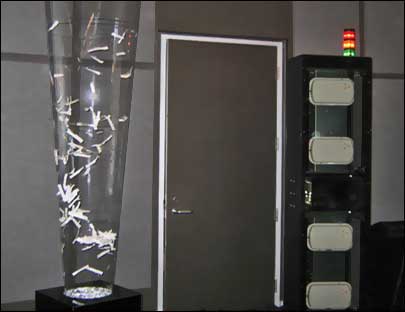Aug 04, 2005One week after announcing it had raised $66 million in its eighth round of funding, Alien Technology introduced the ALR-9800 Enterprise Reader. This is the company’s first reader (or interrogator) designed to be compatible with the EPCglobal Generation 2 UHF Class 1 standard, as well as with Gen 1 UHF Class 1 and Class 0 tags. Alien demonstrated the interrogator at a special event for a group of industry representatives at its Morgan Hill, Calif., headquarters on Tuesday, Aug. 2.
Stav Prodromou, Alien’s CEO, says the interrogator is easy to install and network and can read tags based on multiple protocols. The ALR-9800 complies with global RF regulations, he explains, and can be used to integrate data into enterprise systems. "This is the evolution of EPC technology," Prodromou says.
Keith McDonald, Alien's senior vice president of sales and marketing, states the ALR-9800 was developed largely based on feedback from users of Alien interrogators. According to McDonald, users requested interrogators that could read multiple types of tags, had increased processing power to enable filtering or other applications, and were easier to install and more durable.
Alien used a "tag tornado" (a large, clear plastic tube under which a fan suspended more than 120 tags in a quick-swirling funnel) to demonstrate the ALR-9800 reading a mix of tags, including Gen 2 UHF Class 1 tags, and Gen 1 UHF Class 0, Class 0+ and Class 1 tags. The interrogator's computer interface, projected onto a screen, showed that all but a few of the tags had been read. (The tags that weren’t read seemed to be stuck at the bottom of the structure near the metal fan, which might have caused RF interference.)
The ALR-9800 has two on-board processors. One, the XScale processor from Intel, runs on a Linux operating system and can be used for third-party applications, such as tools to filter RFID tag data. The second is a digital signal processor (DSP), which enables the reader to process the RF signals reflecting off multiple types of tags in its interrogation zone. The DSP can also be used to encode data to tags.
The reader has four ports for multistatic antennas, which can transmit and receive signals. Many interrogators currently on the market require separate antennas for transmitting and receiving signals.
The ALR-9800 has four input and eight output ports that can be used for sensors. For example, an electronic eye can be used in one of the input ports to activate the reader, while a light tree can be used in an output port to indicate whether tags were read successfully. The ALR-9800 can also be placed on autonomous mode, during which it will only search for tags if a sensor attached to the interrogator, such as an electric eye or vibration sensor, awakens it. This helps users reduce the amount of RF activity being generated by individual or networked readers inside their facilities, says Tom Pounds, Alien's vice president of RFID products.
Pounds says Alien has also enabled the ALR-9800 to comply with the dense reader mode (DRM) setting, part of the air interface specification for Gen 2 tags, designed to reduce interference between readers caused by RF noise. (The prototype of the ALR-9800 used in the demonstration, however, does not operate in DRM.) Interrogators must operate in DRM whenever 50 or more are operating within 1 square kilometer.
According to Pounds, the ALR-9800 can run in a "listen before talk" mode, which allows multiple interrogators to detect other readers in operation and avoid interfering with them. This setting is required by the European Telecommunications Standards Institute's 302-208 regulations for radio frequency devices operating in the UHF band.
The ALR-9800 is also backward-compatible with the ALR-9780, which can be upgraded with firmware to read Gen 2 tags. This allows companies to add the ALR-9800 to a network of ALR-9780 interrogators.
The ALR-9800 costs $2,400. Alien is currently taking orders for the interrogator, though it will not be available in production quantities until September.
IBM Partners on ALR-9800
Alien also announced it has partnered with IBM to offer a version of the ALR-9800 that is embedded with IBM's WebSphere RFID Device Infrastructure (WRDI) middleware. This middleware runs on the interrogator's Xscale processor, collecting and filtering tag data. Users of IBM's WebSphere RFID Premises Server can route this filtered data from the ALR-9800 directly into the Premises Server, eliminating the need for a separate middleware layer to aggregate and/or filter RFID tag data.
IBM released the RFID Premises Server and WRDI middleware in December (see IBM Launches RFID Middleware and has also embedded the Device Infrastructure middleware in Intermec's IF-5 Intelligent RFID interrogator and Symbol's XR400 interrogator (see Symbol, Philips Demo Gen 1 and 2).
The ALR-9800 with embedded WRDI will be available in production quantities in September. The cost will be $2,700.


